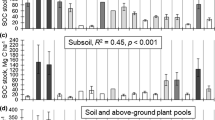Abstract
In the past forests in Central Europe were not only sources of timber and fuelwood but also sources of nutrients to sustain the human population. The use of forests as pastures is still common in some areas while other formerly widespread practices such as litter raking or pollarding have been abandoned. Harvesting of wood, a material of extremely low mineral nutrient content and of wide C/N-ratio depletes nutrients and acid neutralizing capacity at only moderates rates, harvesting of other biomass fractions has a much more severe impact on forest ecosystems. Soil acidification from intensive biomass harvesting of historic land use equaled or exceeded present soil acidification due to the deposition of air pollutants. As a result of historic land use the majority of Central European forest ecosystems was severely depleted of nutrients and acid neutralizing capacity when modern long-rotation forestry became the dominant form of forest land use. At present high deposition rates of acidifying air pollutants prevent the recovery of forest ecosystems in Central Europe. It has to be noted that ecosystem degradation due to excessive biomass harvesting led to systems which were depleted both in nitrogen and acid neutralizing capacity, while high nitrogen deposition rates from Central European air pollution cause a novel combination of progressive soil acidification and concurrent nitrogen saturation. This combination has a high potential for aggravating mineral nutrient deficiencies and nutritional disorders in forest ecosystems.
Similar content being viewed by others
References
Asman WAH, Drukker B and Janssen AJ (1987) Estimated historic concentrations and depositions of ammonia and ammonium in Europe and their origin (1870–1980). Inst for Meteorology and Oceanography (IMOU) Utrecht, Rept R-87-2
Austad I (1988) Tree pollarding in western Norway. In: Birks HH, Birks HJB, Kaland PE and Moe D (Eds) The cultural landscape, past, present and future, pp 11–29. Cambridge Univ Press
Birks HJB, Line JM and Persson T (1988) Quantitative estimation of human impact on cultural landscape development. In: Birks HH, Birks HJB, Kaland PE and Moe D (Eds) The cultural landscape, past, present and future, pp 229–240. Cambridge Univ Press
Castelletti L (1988) Archaeology and forest history. In: Sabiano F (Ed) Human influence on forest ecosystems development in Europe, pp 3–10. ESF FERN-CNR, Pitagora Editrice, Bologna
Chen C and Glatzel G (1988) Vergleich des Bodenzustands unter Buche und Fichte im Wienerwald. In: Führer E and Neuhuber F (Eds) Berichte FIW Symposium 1988, pp 253–254. BMLuF Wien
Ebermayer E (1876) Die gesamte Lehre von der Waldstreu. Springer, Berlin
Emanuelsson U (1988) The relationship of different agricultural systems to the forest and woodlands of Europe. In: Sabiano F (Ed) Human influence on forest ecosystems development in Europe. ESF FERN-CNR, pp 169–178. Pitagora Editrice, Bologna
Englisch M (1987) Versauerung von Waldböden durch Entnahme von Biomasse bei der Holzernte. Diplomarbeit, Univ f Bodenkultur, Wien
Glatzel G and Unteregger E (1987) Nährstoffentzug und Bodenversauerung in Pappel-Energieholzplantagen. Österr Forstzg 4: 58–59
Hager H (1988) Stammzahlreduktion: Auswirkungen auf Wasser-, Energie- und Nährstoffhaushalt von Fichtenjungwüchsen. Forstl Schriftenreihe, Univ f Bodenkultur, Wien, Bd 1
Hasel K (1985) Forstgeschichte: Ein Grundriß für Studium und Praxis. Parey, Hamburg, Berlin
Krapfenbauer A (1983) Von der Streunutzung zur Ganzbaumnutzung. Cbl ges Forstwesen 100: 143–174
Kreutzer K (1972) Über den Einfluß der Streunutzung auf den Stickstoffhaushalt von Kiefernbeständen. Forstw Cbl 91: 263–270
Nilsson SI, Miller HG and Miller JD (1982) Forest growth as a possible cause of soil and water acidification: an examination of the concepts. Oikos 39: 40–49
Ramann E (1883) Die Einwirkung der Streuentnahme auf Sandböden. Zeitschrift f Forst- u. Jagdwesen 11: 577 & 12: 633
Rehfuess KE, Bosch Ch and Pfannkuch E (1983) Nutrient imbalances in coniferous stands in Southern Germany. Comm Inst Forest Fenniae 116: 122–130
Schulze E (1989) Air pollution and forest decline in a spruce (Picea abies) forest. Science 244: 776–783
Sterba H (1988) Increment losses by full-tree harvesting in Norway spruce (Picea abies). Forest Ecology and Management 24: 283–292
Tyrol Soil Survey 1988: Bericht über den Zustand der Tiroler Böden 1988. Amt der Tiroler Landesregierung, Innsbruck, Austria
Ulrich B, Mayer R and Khanna PK (1980) Chemical changes due to acid precipitation in a loess derived soil in Central Europe. Soil Science 130: 193–199
Van Miegrot H and Cole DW (1985) Acidification sources in red alder and douglas fir soils-importance of nitrification. Soil Sci Soc Am J 49: 1274–79
Zech W, Suttner Th and Popp E (1985) Elemental analysis and physiological response of forest trees in SO2-polluted areas in NE-Bavaria. Water, Air and Soil Pollution 25: 175–183
Zöttl HW and Mies E (1983) Nährelementversorgung und Schadstoffbelastung von Fichtenökosystemen im Südschwarzwald unter Immissionseinfluß. Mitt Deutsch Bodenkundl Ges 38: 429–434
Zöttl HW and Huettl RF (1986) Nutrient supply and forest decline in Southwest-Germany. Water, Air and Soil Pollution 31: 449–462
Author information
Authors and Affiliations
Rights and permissions
About this article
Cite this article
Glatzel, G. The impact of historic land use and modern forestry on nutrient relations of Central European forest ecosystems. Fertilizer Research 27, 1–8 (1991). https://doi.org/10.1007/BF01048603
Received:
Accepted:
Issue Date:
DOI: https://doi.org/10.1007/BF01048603



